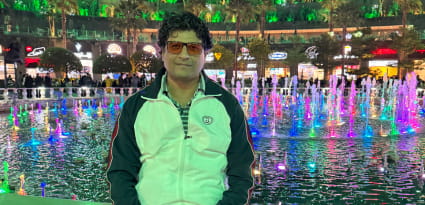
JHAH surgeon discovers glass shard in patient’s eye that went undetected for nearly 15 years
An unusual accident in 2010 left Muhammad Ahmad with blurred vision and pain in his left eye. Doctors were unable to determine the cause – until he was referred to a JHAH ophthalmologist.
Muhammad Ahmad was on his way to buy groceries in London, UK, when he walked by a workman conducting maintenance on the street. Suddenly, there was an explosion.
Glass shrapnel shot across the street in all directions. As the dust settled, Muhammad realized that several shards of glass were stuck in his face.
He found one shard embedded in his cheek near his mouth and quickly removed it. He then sought medical attention at a nearby hospital, where clinicians discovered and removed several glass fragments around his left eye. He was given eye ointment to stave off infection and sent home.
His wounds healed quickly, and he believed all was well.
Years passed, and then, in 2020, the coronavirus pandemic struck. Muhammad contracted Covid-19 in October that year and soon began suffering from pain and blurred vision in his left eye. “I couldn’t see more than two feet ahead,” he remembers. From that point onwards, he experienced persistent discomfort and problems with his vision.
Physicians initially diagnosed Muhammad with disciform keratitis, a viral infection of the cornea. They prescribed him short courses of oral antiviral medication and topical corticosteroids, which alleviated his condition temporarily — but then the blurriness and pain returned.
In October 2024, Muhammad was referred to Dr. Mouhamed Al Aqaba, a consultant ophthalmologist at Johns Hopkins Aramco Healthcare (JHAH), who specializes in cataract and corneal surgery. “Dr. Al Aqaba performed a series of tests and discovered a tiny glass particle, with several sharp edges, just behind my cornea,” Muhammad says. “The doctor said he’d never seen anything like it in his life.”
Dr. Al Aqaba and his team confirmed the diagnosis with ultrasound biomicroscopy, which captures images of the anterior segment of the eye, and optical coherence tomography, which creates 3D images of the rear of the eye.
Dr. Al Aqaba says Muhammad’s case was “very rare” given that the glass shard had been in his eye for nearly 15 years. “The worry was that the foreign body could be extremely adherent to the underlying iris tissue,” Dr. Al Aqaba explains. “In addition, manipulation of the foreign body during the surgery could result in further damage to the cornea or the crystalline lens of the eye. But leaving the glass shard in the eye could have caused progressive structural damage to the cornea and the underlying ocular tissues, and potential blindness. So, surgery to remove the shard was the best option.”
Dr. Al Aqaba performed surgery in January this year. “It was a great success,” he says.
We were able to remove the glass particle while causing no damage to Muhammad’s eye. We then sent the particle to microbiology to check there were no microbes on its surface, and the result came back negative. Ahmed has since been reviewed in clinic and has recovered fully. His left eye has 20/20 vision, and his cornea appears to be normal.
Muhammad, now 48 years old, says: “I can see perfectly well from my left eye now, and I haven’t had any pain since surgery. I am most grateful to Dr. Al Aqaba and his team for their outstanding care.”
Learn more about ophthalmology services at JHAH
